The Trillion Setting Engagement Ring: A Detailed Overview
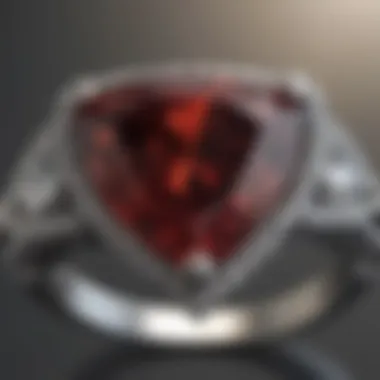
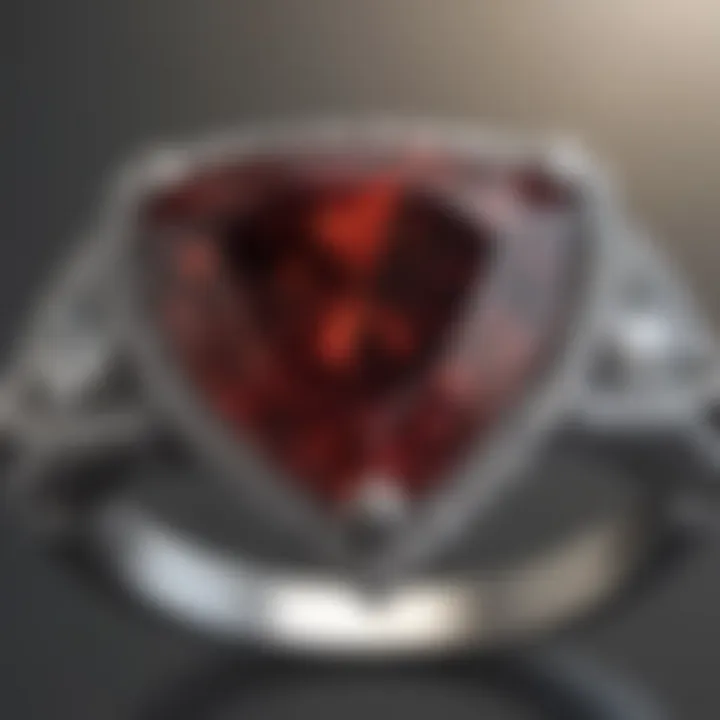
Intro
Engagement rings have long been considered not just a piece of jewelry, but a profound symbol of love and commitment. Among the myriad of styles available, the trillion setting engagement ring stands out, showcasing a unique triangular cut that holds both beauty and significance. This exploration aims to shed light on the distinctive features of trillion setting engagement rings, diving into their historical background, the intricacies of their design, and the thoughtful choices involved in selecting the right gemstone. In a world where craftsmanship meets ethical considerations, understanding these rings offers invaluable insight for both consumers and connoisseurs alike.
Gemstone Overview
Definition and Origins
The trillion cut is a modern, triangular-shaped gemstone design that was popularized in the 1970s. Its name, derived from the word 'trillionth' reflects its distinctive shape, substantial brilliance, and ability to showcase a stone's color. This cut maximizes the gemstone's surface area, allowing for exceptional light reflection and refraction. Contrary to more traditional cuts, the sharp corners of the trillion shape often provide a more contemporary look, making it an attractive option for many.
Historical Significance
Historically, gemstones have been valued not only for their beauty but also for their supposed mystic properties. The trillion cut quickly became associated with innovation in gemstone cutting, allowing designers greater freedom in creating unique and intricate jewelry pieces. The rising popularity of the trillion cut coincided with a growing appreciation for modern design in the late 20th century, reflecting a shift in consumer tastes. With its roots in the contemporary movement, it symbolizes both innovation and timelessness.
Gemstone Properties
Hardness and Durability
Crafting a piece of jewelry that endures the test of time involves more than just aesthetic choices. The hardness and durability of a gemstone are critical factors in ensuring that it withstands everyday wear. The Mohs scale of mineral hardness measures this property, with diamonds ranking at a hardiness of 10. The hardness of a trillion-cut diamond makes it a prime candidate for engagement rings, as it can resist scratches and damage that softer stones cannot. Other gemstones, such as sapphires, also rate high on this scale, making them worthy contenders.
Color and Clarity
When evaluating gemstones, both color and clarity play pivotal roles in determining their overall quality. The vibrant hues of a stone can enhance its visual appeal. For instance, a blue sapphire set in a trillion cut is known to radiate intensity and depth that captivates the eye. Clarity refers to the presence of inclusions or blemishes within the stone; fewer intrusions generally mean a more desirable gem.
- Color Variations: Trillion cut stones can showcase a variety of colors, from the deep blues of sapphires to the fiery reds of rubies.
- Importance of Clarity: Higher clarity often translates to higher value; however, some gem enthusiasts prefer stones with minor inclusions as they give character and uniqueness.
With these facets in mind, choosing a gemstone for a trillion setting engagement ring becomes not just about personal taste but an understanding of the attributes that make each stone special.
"A gemstone isn't simply a rock; it's a story waiting to be told, encapsulating moments of time, culture, and artistry."
Understanding Trillion Cut Gems
The world of gemstones is as intricate as it is beautiful. Understanding the trillion cut is essential for anyone considering an engagement ring. This cut, characterized by its sharp, triangular shape, marries art and precision in a way that captures the light and highlights the stone's natural beauty. Its historical significance and unique characteristics make it a favored choice for those who seek something distinctive in their jewelry.
A brief history provides context. The trillion cut originated in the late 1970s and early 1980s, crafted to provide maximum brilliance and sparkle. Unlike traditional cuts, the trillion cut emphasizes facets that reflect light at multiple angles. This makes the design truly captivating. Additionally, it has gained popularity for engagement rings as a symbol of individuality, offering a refreshing alternative to the more conventional round brilliant cuts.
Understanding the trillion cut is not just about aesthetics but also investing in quality. For collectors and enthusiasts, knowing the intricacies—like the angles, proportions, and the type of gem used—can greatly influence perception and value. The right trillion cut gemstone can meld seamlessly into various designs, making it a versatile choice for a variety of styles.
The Origins of the Trillion Cut
The trillion cut emerged from the gemological community when jewelers began to experiment with ways to maximize the light return from gemstones. Originally popularized by the famous jeweler, Sir George Everest, this cut inspired artisans hoping to create pieces that stand apart in the competitive jewelry market. The design fosters an innovative approach to traditional cuts, crafting a symmetrical triangle that captivates the beholder's eye.
Characteristics of Trillion Cut Stones
Understanding the characteristics specific to trillion cut stones will guide prospective buyers toward making informed choices.
The triangular shape
The triangular shape is the most striking aspect of the trillion cut. This unique silhouette brings a fresh perspective to gemstone settings. Unlike standard shaped stones, the triangular form gives an edge—literally and figuratively—to the jewelry design. Individuals drawn to strong geometric lines find this shape to be particularly appealing. Its intriguing angles also add dynamic visual intrigue, drawing attention to the wearer's finger. This shape can make fingers appear more elegant due to the sleek lines and dramatic contrast it creates. However, one must be cautious; the sharp corners can be more prone to chipping compared to round gemstones, requiring more diligence in wear and care.
Unique facets and brilliance
The unique facets of a trillion cut gemstone are engineered to enhance brilliance. Each facet is strategically placed to maximize reflection and refraction, ensuring that the stone catches the eye in any light. The triangular sides lend themselves well to different lighting environments, allowing the stone to practically sparkle. Prospective buyers appreciate this brilliance as it serves to elevate even the simplest of designs. These cuts are, however, more challenging to execute, requiring a skilled lapidary expert to achieve that signature shine. Fine craftsmanship is key, making it a worthwhile investment.
Color range and clarity considerations
Lastly, the color range and clarity of trillion cut stones can vary widely, impacting their desirability and value. Notably, transparency and vividness of color play a pivotal role in determining the ring's overall appeal. Buyers may find themselves enchanted by deep blues of sapphires or vivid greens of emeralds. However, clarity is equally important. A perfectly cut trillion gem with slight inclusions may lose brilliance when looked at closely.
Moreover, it’s crucial to do some homework before purchasing. Buyers should consider the GIA grading system, which helps in evaluating the quality of colored gemstones based on factors like hue, tone, and saturation. This understanding promotes discerning choices, ensuring satisfaction with the final piece.
The trillion cut blends modern artistry with timeless elegance, making each engagement ring a statement piece.
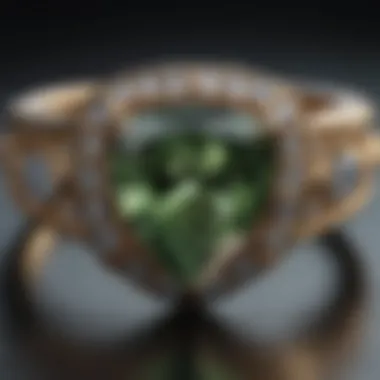
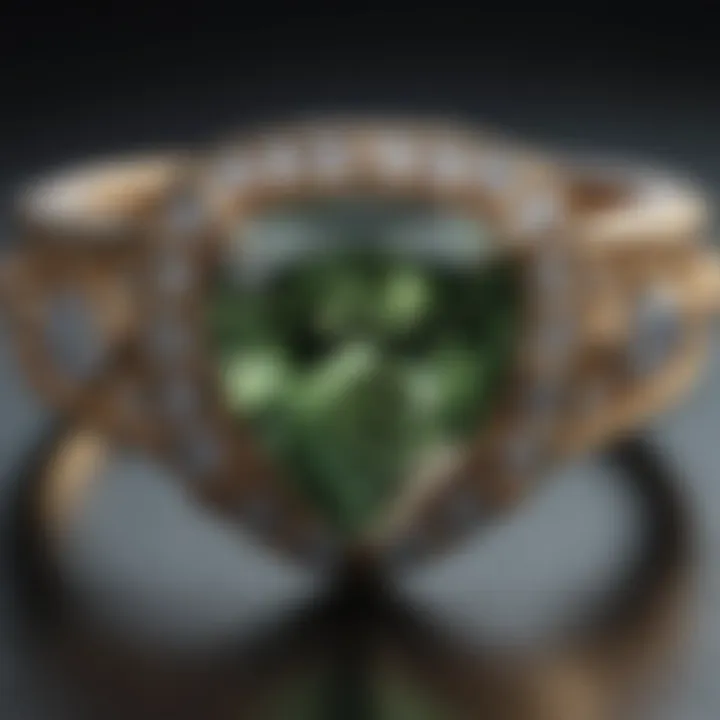
Acquiring knowledge about the trillion cut enriches the overall experience of selecting an engagement ring. It’s more than a mere aesthetic consideration—this understanding provides insights into craftsmanship, paving the way for meaningful choices.
The Appeal of Trillion Setting Engagement Rings
When it comes to choosing an engagement ring, many people gravitate toward styles that encapsulate their personal taste and eloquence. Among these options, the trillion setting stands out conspicuously, offering a blend of timeless elegance and contemporary flair. This section examines the appeal and allure of trillion setting engagement rings by diving into their symbolism, visual impact, and the unique aesthetics they bring to the table.
Symbolism and Significance
The meaning of the triangular shape
The triangular shape of trillion cut gems is not just for show; it carries a deep significance. The shape can symbolize balance, unity, and harmony. As basic and fundamental as triangles are to geometry, they also embody stability and strength. Choosing this cut for an engagement ring can reflect the principles of a strong relationship—where partners support each other to maintain equilibrium in their lives. Thus, the triangular aspect of the ring makes it a popular choice among those who value representation and meaning in their jewelry. Moreover, its sleek appearance brings a modern twist to classical designs, appealing to both the traditionalist and the avant-garde.
Representing life and equilibrium
Life itself can often feel like a balancing act, and the trillion setting echoes this sentiment through its design philosophy. The triangular shape not only illustrates the idea of balance but also signifies life's interconnected aspects—love, friendship, and commitment. The ring serves as a physical reminder of how partners navigate life together, sustaining equilibrium despite life's ups and downs. This perspective adds a layer of resonance to the wearer's experience, enriching the symbolism of the ring beyond mere aesthetics. As they wear it daily, the significance of balance and unity may serve to strengthen relationships.
Visual Impact and Aesthetics
Showcasing the gemstone's properties
Trillion cut engagement rings distinctly highlight the properties of the gemstone used in the setting. Due to the unique facets and angles of the cut, light interacts with the stone in various captivating ways, revealing a multitude of colors and depths of brilliance. This characteristic not only amplifies the stone's inner fire but also increases its appeal to gemstone connoisseurs. Hence, for those who appreciate the qualities of natural stones, this cut exists to make the most of your chosen gem, turning the limelight on its exquisite features. Looking at a well-crafted trillion cut stone, even the least discerning eye might find it hard not to be captivated.
Complementing various styles
The versatility of trillion setting engagement rings is an undeniable asset. This shape can harmonize beautifully with multiple styles, offering a striking complement to various jewelry aesthetics—whether minimalist, vintage, or even art deco. This characteristic opens up a world of possibilities, making it remarkably easy for wearers to mix and match with their existing jewelry. Featuring a trillion setting in a bold metal finish or ornate detailing can define a personal look while still celebrating the essence of the gem itself.
This exploration has shown that the appeal of trillion setting engagement rings lies not only in their visual beauty but also in the symbolism they carry. From representing life's balance to showcasing the leads of the gemstone's brilliance, these rings promise more than just an aesthetic experience; they offer a narrative that enriches the wearer's connection to the ring.
Design Considerations for Trillion Settings
When it comes to crafting a splendid engagement ring, the design considerations for trillion settings are crucial. This section dives into the core elements that play a pivotal role in making a trillion setting work beautifully, from the choice of metal to style variations. The right design not only enhances the aesthetic appeal of the ring but also ensures longevity, comfort, and wearability.
Choosing the Right Metal
Choosing the right metal for a trillion setting can significantly affect both the ring’s durability and its overall look. Different metals offer varying qualities, which is why it’s essential to weigh your options carefully.
Platinum vs. Gold
When comparing platinum to gold, one characteristic stands out: durability. Platinum is denser than gold, which means it can withstand wear and tear better over time. It offers a luxurious sheen that captivates without overshadowing the gemstone itself. However, while platinum can last a lifetime, it does come with a higher price tag. On the flip side, gold, available in shades like yellow, rose, and white, gives a classic and vibrant look but may need more maintenance to keep it looking its best as it tends to scratch more easily.
Moreover, platinum’s unique feature is its hypoallergenic properties, making it suitable for individuals with sensitive skin, while gold can contain alloys that may irritate some skin types. This choice certainly comes down to personal preference, budget, and lifestyle considerations.
White Gold vs. Yellow Gold
When it’s white gold against yellow gold, the decision often lies in aesthetic preference and maintenance. White gold, typically plated with rhodium, offers a modern and sleek appearance that complements the sparkle of a trillion-cut gemstone beautifully. In contrast, yellow gold delivers a warm and vivid tone that showcases the ring’s elegance.
A unique feature of white gold is its shine and reflectivity, which enhances the brightness of diamonds and other clear gemstones. However, it may require occasional re-plating to maintain that shiny finish. Yellow gold, on the other hand, is renowned for its rich color and timeless quality but can show wear over time if not cared for.
Setting Styles and Variations
The style of the setting itself can make or break the visual impact of a trillion setting. Different styles can showcase the gem’s brilliance in unique ways, allowing wearers to express their character and taste.
Classic Solitaire Settings
The classic solitaire setting is a tried-and-true choice that always shines bright. This minimalist approach expertly emphasizes the trillion-cut gemstone by keeping the focus squarely on the stone itself. Its key characteristic is simplicity, which ensures that the ring remains timeless. The advantage here is that it allows for easy pairing with other jewelry and is endlessly adaptable to personal style. However, less can sometimes be more, and those looking for intricate design might find it lacking.
Three-Stone and Halo Variations
Three-stone and halo settings offer a different flair, providing a little extra something special to your engagement ring. A three-stone setting incorporates two side stones that can either contrast or complement the center trillion gem, symbolizing the past, present, and future of a couple's love. Its appeal lies in the narrative it tells. Conversely, the halo variation surrounds the central stone with smaller gems, amplifying the overall sparkle and size perception of the ring.
However, choosing a more elaborate design may require more time and effort in upkeep, as it can be more susceptible to dirt and damage.
As you weigh these various considerations, remember that the engagement ring should not only reflect your style but also tell a story—a narrative that's uniquely yours.
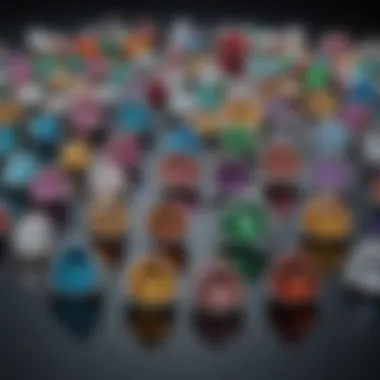
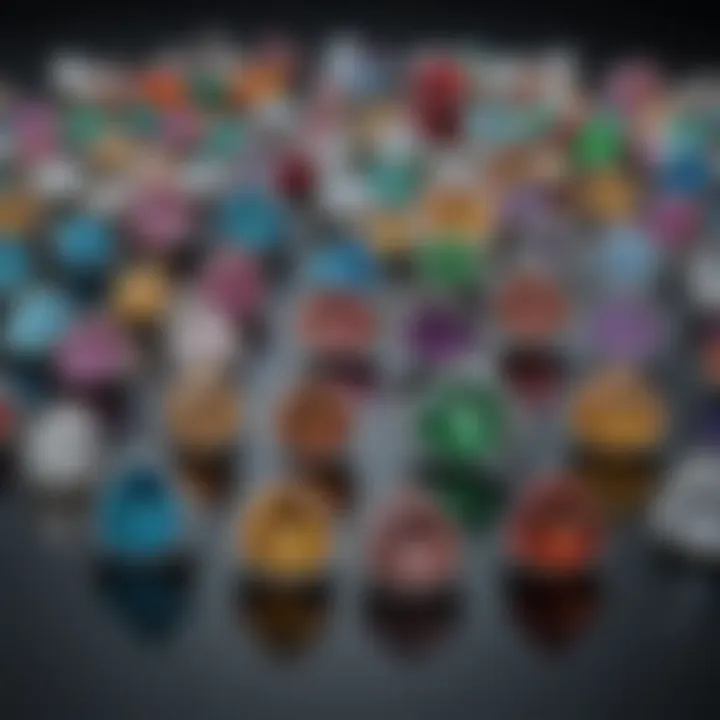
Gemstone Selection for Trillion Rings
Selecting the right gemstone for a trillion setting engagement ring is paramount. It’s not just about aesthetics but also about finding the stone that represents the bond you share with your partner. The gemstone serves as the focal point, and its qualities can symbolize various attributes and emotions that make your relationship unique. In a world where personal expression is highly valued, the right choice can also reflect your partner's individual style and taste. Choosing a gemstone isn't merely a decision; it can speak volumes about your affection.
Popular Gemstones in Trillion Cuts
Diamonds
Diamonds stand tall as the most sought-after gemstone, especially for engagement rings. Their renowned hardness and brilliance make them a top choice. When you gaze into a diamond—in its trillion cut—you’ll notice an unrivaled sparkle. This is due to their incredible light refraction and dispersion, which sends light bouncing in every direction. One of the unique features of diamonds is their ability to convey strength and endurance, ideal for a lasting commitment.
However, diamonds do come with their share of concerns. They can also draw attention away from the ring’s overall design, as they sometimes dominate the visual space, potentially overshadowing the band or surrounding stones.
Sapphires
Sapphires, famously known for their deep blue hue, offer a different flair than traditional diamond engagement rings. Their key characteristic is their depth of color, which reflects a range of emotions, from tranquility to loyalty. The use of sapphires in trillion cutting has gained traction as these vibrant gemstones possess a unique quality of elegance.
Sapphires are celebrated not only for their color but also for their durability, sitting at a 9 on the Mohs scale. This makes them incredibly suitable for everyday wear. A downside could be their historical ties; some may associate sapphires less with engagement than diamonds, affecting their popularity somewhat.
Emeralds
Emeralds represent a different path in the gemstone landscape. Known for their lush green tones, they are considered symbols of rebirth and love. The unique feature of emeralds lies in their rich color, which can infuse a ring with a stunning pop of green that’s hard to match. When placed in a trillion setting, an emerald can draw attention like no other stone.
Yet, they come with challenges. Emeralds often have inclusions, referred to as “jardin,” that can affect their clarity and appeal. This makes them more brittle than diamonds or sapphires, thus needing careful handling and maintenance to avoid chips or scratches. Still, their enchanting allure is hard to resist, especially for those who admire natural beauty.
Evaluating Quality and Color
Understanding color grading
Understanding color grading is essential when choosing the right gemstone. This process determines the quality and value of the stone, providing a framework for distinguishing between high-quality and lower-quality options. Grading evaluates hue, saturation, and tone, which directly impact the final look of the gemstone.
The unique feature of this grading system is its universal standards, allowing for an informed selection process. Knowledge of color grading can equip buyers to make more educated choices, potentially saving money by avoiding overpaying for poor-quality stones. However, navigating this can be complex—there are many factors at play.
Assessing clarity and cut
Assessing clarity entails examining a gemstone for any defects, which can impact its beauty and sparkle. Clarity and cut are both pivotal in defining how a gemstone interacts with light. A well-cut trillion allows for maximum brilliance, whereas flaws can substantially detract from the overall visual impact.
This is beneficial for those seeking exceptional quality. Unique to clarity is its capacity to highlight a gem’s personality—each stone tells a different story based on its clarity grade. The downside? Higher clarity can come with a larger price tag, making it a trade-off between budget and aesthetics for many.
Ultimately, your choice in gemstones should balance personal preference with expert insights, ensuring that your trillion setting engagement ring is as unique as your journey together.
Finding the right stone demands thoughtful consideration, but it rewards you with a piece that captivates and endures. Selecting a gemstone isn’t just about the visual��—it’s about what it communicates, both to your partner and to the world.
Understand, evaluate, and choose wisely.
Ethical Considerations in Gemstone Sourcing
When one thinks about engagement rings, the focus is often on the beauty and symbolism of the gemstones. However, an equally important aspect that deserves attention is the ethical consideration in sourcing these precious stones. In a world increasingly conscious of environmental and social responsibilities, understanding where and how your gemstone is sourced can have a profound impact on your purchasing decision. This section aims to highlight the significance of ethical sourcing as well as the concept of fair trade gemstones.
The Importance of Ethical Sourcing
First and foremost, ethical sourcing refers to the responsible identification of gem materials, ensuring they are acquired in a way that is environmentally friendly and socially just. This doesn't just encompass the welfare of the miners but extends to the entire community involved in the extraction and sale of these gemstones.
Here are some key elements to consider:
- Social Responsibility: Ethical sourcing focuses on improving the conditions of workers within gemstone mining operations. Many traditional mining practices can lead to exploitation, poor working conditions, and underpayment. Choosing ethically sourced gems supports fair wages and better working conditions for miners.
- Environmental Impact: Mining operations can severely damage ecosystems. An ethically sourced gemstone means that efforts have been made to reduce environmental harm and manage resources sustainably. This includes practices like land reclamation and utilizing techniques that minimize damage to habitats.
- Transparency and Traceability: Ethical sourcing champions the need for transparency in the supply chain. Awareness about where your stone comes from and how it has been extracted empowers consumers to make informed decisions, ensuring they invest in products that align with their values.
"Consumer choices can change the landscape of the ethical jewelry industry, forcing companies to adapt or risk losing customers who are now more discerning than ever."
Fair Trade Gemstones
Fair Trade Gemstones is an integral component of ethical sourcing. While the concept of fair trade originated in agricultural markets, it has gradually found its way into the gem industry. Here’s how it operates:
- Fair Pricing: Fair trade ensures that miners receive a fair price for their stones, often above market rates. This economic empowerment allows miners and their communities to thrive rather than merely survive.
- Community Benefits: Revenue generated from fair trade practices can be reinvested in local communities, funding vital services such as education and healthcare. Thus, purchasing fair trade gemstones not only benefits the miner but also uplifts surrounding families and communities.
- Quality Over Quantity: Sourcing fair trade gemstones typically emphasizes quality craftsmanship, ensuring that the gems are not only ethically acquired but also of a superior standard. Each piece carries a story and represents the effort put into it, making it worth even more on the emotional level.


Investing in gemstones that are ethically sourced signifies a commitment to a broader narrative of respect, responsibility, and sustainability. As you search for that perfect trillion setting engagement ring, consider how the choices you make resonate with your values. By aligning personal joy with global responsibility, the act of proposing—and the ring itself—transforms into a more profound symbol of love.
Caring for Your Trillion Setting Engagement Ring
When it comes to engagement rings, particularly those featuring a trillion setting, proper care is key. These rings can be a significant symbol of love and commitment. Therefore, maintaining their beauty and integrity is essential. Not only does this involve routine cleaning, but it also encompasses careful storage and protective measures to ensure that your investment remains in pristine condition over the years.
Cleaning and Maintenance Tips
Appropriate cleaning solutions
Keeping your trillion setting engagement ring clean goes beyond merely wiping it down. Using suitable cleaning solutions can greatly affect not only the appearance of the ring but also its longevity. One popular choice is a gentle detergent mixed with warm water. This concoction is effective without being harsh on the stone or metal.
The key characteristic of a good cleaning solution is its ability to remove dirt and oils without scratching or dulling the shine of the ring. If you're interested in something a bit more specialized, consider solutions designed specifically for gemstone jewelry. These products often have unique features that can restore the brilliance of the trillion cut, highlighting its facets beautifully.
However, caution is always advised. Some specialized cleaners may contain chemicals that can damage certain gemstones or metals. Thus, it's wise to read the labels thoroughly and consult with a jeweler if you're unsure.
Professional servicing
While regular cleaning at home is important, there are moments when your engagement ring could benefit from professional servicing. This usually includes checks for loose stones, retipping prongs, or even full polishing. A professional can highlight any wear or issues that may not be visible to the untrained eye.
The hallmark of professional servicing is the expertise offered by trained jewelers. Their knowledge is a significant advantage when it comes to maintaining the integrity of your ring. The unique fabric of professional servicing means it goes deeper than just cleaning; it's about ensuring that the ring remains as secure and brilliant as when you first laid eyes on it.
Nonetheless, professional servicing does come with its costs. Depending on required work, the expenses can add up, so plan on investing in this aspect on occasion, balancing between regular at-home care and occasional professional tidying.
Storage and Protection Methods
Using ring boxes
One essential aspect of caring for your trillion setting engagement ring is proper storage. Using ring boxes is one of the most effective methods for preventing damage. A high-quality ring box can shield the ring from dust, dirt, and physical harm. It isn't merely a case; it serves as armor, so to speak.
The notable feature of good ring boxes is their cushioning, often lined with soft materials that prevent scratching while keeping the ring secure. A designated ring box is a beneficial choice, as it minimizes the risk of misplacing the ring, especially in a cluttered setting.
However, make sure to choose a box that offers adequate protection. Not all boxes are created equal, and selecting one that has a secure clasp and a sturdy exterior is wise.
Preventing scratches and damage
This brings us to the importance of preventing scratches and damage, perhaps one of the most practical concerns for jewelry owners. Even a small scratch can mar the otherwise stunning surface of a trillion cut gemstone. To do this, it's advisable to think about where and how the ring is worn.
Key considerations here include being mindful of tasks or activities where the ring might come into contact with hard surfaces. Think cleaning, certain sports, or manual labor. Wearing the ring only during special occasions might be an option you might consider.
Another aspect is avoiding stacking rings. If you combine your trillion engagement ring with other pieces, the friction between them can cause wear. Each approach to prevent damage carries its own unique features and challenges. Weighing the pros and cons is key.
In summary, caring for your trillion setting engagement ring involves a few critical practices, from cleaning routines to safe storage options. Investing time and effort into these care aspects not only preserves the beauty of the ring but also ensures it remains a cherished symbol for years to come.
Popular Trends and Innovations in Trillion Settings
The world of jewelry is ever-evolving, and when it comes to trillion setting engagement rings, trends and innovations play a crucial role in shaping the choices available to individuals. These trends not only reflect personal style but also emphasize the craftsmanship and unique qualities of each ring.
Emerging trends highlight the individualistic nature of these rings, making them a popular choice for couples who desire something distinctive. The increase in variety and customization options contributes to the ring's allure, fundamentally changing how people view engagement rings when it comes to expression and meaning.
Emerging Design Trends
Mixed gemstones
One fascinating trend is the use of mixed gemstones in trillion settings. This approach not only adds color but also introduces a playful element to traditional designs. By combining different gemstones like sapphires and garnets, couples can create rings that truly reflect their personalities. The key characteristic of mixed gemstones is their ability to harmonize distinct colors and textures, making each piece unique.
One benefit of opting for mixed gemstones is the limitless creative potential. While individual gemstones may have their charms, blending various stones cultivates a visual richness that stands out. This method can highlight the vibrancy and luminosity of each gemstone, allowing for a striking combination that draws the eye. However, balancing different colors can be a challenge, as one dominant color might overshadow the others. Hence, careful consideration is needed during the selection process to achieve that harmonious blend.
Customized settings
Customized settings offer another avenue for creativity in trillion ring designs. Tailoring a setting ensures that each ring mirrors the wearer’s style and preferences. This trend tends to revolve around the unique characteristic of personalization, allowing for an embodiment of various elements—perhaps a specific design motif or an unusual band shape that matches the gemstone.
The beauty of customized settings lies in their unique feature—every detail can be crafted to order. From engraving a special date to selecting the exact metal and finish, couples can develop a piece that's as exceptional as their love story. However, customization can also present drawbacks. The longer timeline and potentially higher cost are factors to keep in mind. But for many, these complications are well worth the final outcome when they hold a truly one-of-a-kind engagement ring in their hands.
Technological Advances in Gemstone Cutting
In addition to design trends, advancements in technology have dramatically influenced how gemstones are cut and shaped today. Innovative machinery and techniques have increased precision and efficiency in the cutting processes. For instance, laser cutting technology allows gem-cutters to achieve intricate designs that would have been challenging, if not impossible, to create using traditional methods.
With such advancements, the sparkle and brilliance of trillion cut stones have seen unparalleled enhancement. Sooner rather than later, consumers might find more options that were once only streamlined through family heirlooms or artisan crafts. Therefore, understanding these trends in both design and technology is essential for anyone looking to indulge in the rich world of trillion setting engagement rings.



